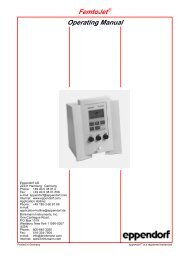DM6000 CFS.qxd:DM6000 CFS - Duke University Light Microscopy ...
DM6000 CFS.qxd:DM6000 CFS - Duke University Light Microscopy ...
DM6000 CFS.qxd:DM6000 CFS - Duke University Light Microscopy ...
Create successful ePaper yourself
Turn your PDF publications into a flip-book with our unique Google optimized e-Paper software.
Two worlds in oneTwo completely different experimental requirements can be satisfiedwith one single system. The Leica TCS SP5 with the TandemScanner provides classical morphology on large samples, wherehigh spatial resolution is required, e.g. research on structures ofcytoskeleton, organelles or tissues, as well as physiology and biophysicsimaging, where temporal resolution becomes very important.Double labeled neurons of brain slices.Courtesy of Thomas Nevian, Institute ofPhysiology, Bern, SwitzerlandCalcium is an important second messenger to trigger many signallingcascades in neurons. Functional imaging of calcium influxis possible with calcium ion sensitive indicator dyes, but calciumtransients in neurons are very fast. Therefore, they are typicallyrecorded in line scan mode, also known as xt-scan mode. Thelaser beam is continuously scanned back and forth along thesame line and fluorescence over time is recorded. The resultingimage consists of one spatial and one time axis. The resonantscanning system of the Leica TCS SP5 oscillates at 8000 Hz,enabling a line rate of 16,000 lines per second. Fast dynamics ofinitial calcium inflow can now be investigated.Even in the xy-scan mode, the scan rate can be as high as 180frames per second in the frame size 512 x 64. This frame rateenables imaging of extended regions of the dendritic tree andmultiple spines at the same time.Confocal interface8










